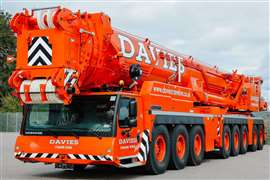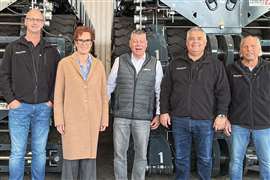Construction hoists for modern builds
06 April 2021
Construction hoist design is being influenced by the wider construction industry, while manufacturers of hoists are looking into the future as they create products that are suitable for modern building shapes and specifications.
 Maber’s twin mast transport platform/material hoist with 5 tonnes capacity at Battersea Power Station in London. Seven units were supplied to the jobsite.
Maber’s twin mast transport platform/material hoist with 5 tonnes capacity at Battersea Power Station in London. Seven units were supplied to the jobsite.
Diego Benetton, sales director at Maber, says the requirements of worksites remain broadly consistent but there are demands for bigger units due to changing technologies in the construction field. “To minimise the cost of buildings, the trend is to pre-make parts ready for installation as much as possible. For this reason, there’s a need for bigger decks and higher capacity, as well as considerable speed to building height.”
As in most areas of the access industry, and beyond, electronics is another subject that rental companies are focusing on. In the past, Benetton says, “Construction hoists have been treated as raw products on the jobsite, leaving the operator with most of the liability for maintenance and service.”
Nowadays, many hoists are remotely driven, and those that retain an operator have been upgraded with electronics to provide greater lifting speeds and functionality. “It is now a must to service them properly, considering these big units need skilled technicians.”
For this reason, the manufacturer has launched its Maber Remote Control System, with the idea of providing an ‘eye on site’, along with its ability to modify the configuration of the machine and troubleshoot remotely. In 2020, the company upgraded this further with Mymaber, a website to provide owners with a real time view of the hoist, as well historical data, along with relevant documents for it.
New combination
On the product side, Maber will start delivering its new 2,000kg hoist in April. It represents a combination of its longstanding 2 tonne hoist and another unit launched in 2018. As with previous versions, it will have a single mast with self-adjusting speed between 40 and 53m/min. The cage dimension is 1.5 x 3.2 x 2.1m. And it will have a large C door option. In addition to the 2 tonne hoist, Maber is updating its large range of hoists with the plan to present them at Bauma 2022.
 The new Alimak LSH inside an elevator shaft
The new Alimak LSH inside an elevator shaft
With an eye on global trends, Alimak launched its LSH construction hoist at Bauma China 2020, in November. The Alimak LSH is designed for use inside elevator shafts during building construction.
It offers several features, which enhance efficiency and drive productivity in comparison to traditional traction jump-lifts. The hoist, which can serve the highest floors, can be installed quickly with jumping operations doubling in efficiency. The LSH is able to serve the top level of the construction site due to the rack and pinion technology used. It also has a large 7 inch display control panel in a stainless-steel casing. The touchscreen has protective glass and ingress protection to IP54, while Alimak’s intelligent hoist monitoring system delivers real-time status information.
Again, intelligence is a vital element of current and future product design, says David Batson, executive vice president at Alimak Group’s construction division. In addition, Batson sees a new future, with significant change and disruption to the construction industry. “Previously it was considered ‘if’ change will come, it’s now a matter of when.
“With the impact of Covid-19, we are seeing the sector like many others, rapidly looking for ways to improve productivity. As the ecosystem of a construction site moves and adapts players need to move quickly or be left behind. The logistics and supply chain and the digitalisation of that is something being embraced and is moving quickly in many markets globally along with sustainability.”
Another challenge, says Batson, is low productivity growth in the construction market over the last 20 years, comparative to the wider economy; so the challenges in the sector are related to project time and cost overruns. “This results in dissatisfied developers and costly claims, and was the case well before Covid-19 struck the sector,” Batson adds.
The latest from Raxtar is the RX Smart Series. With a payload capacity of 2300kg and a lifting speed of 36m, the series is ideal for construction projects with a focus on the mid-rise market, from 25m to approximately 75m.
The hoist comes standard with a C-gate, full height ground enclosure, touch panel (or joystick), programmable landings, a hoist calling system, RX Cloud management tool and it is compliant with European and North American standards. Over recent months Raxtar’s own rental fleet has been extended with these new hoists.
Complex structures
 The new RX Smart series from Raxtar
The new RX Smart series from Raxtar
In the second half of 2021, Raxtar will come out with a new Common Tower offering and set-back system. “With building and facade shapes becoming less straightforward and increasingly more challenging, bridging the gap between the construction hoist and its landing in the building is a continually more frequent subject to cope with,” says Danielle Schaapsmeerders,
Raxtars lead for customer care. The set-back system aims at providing a standard and modular solution that is safe, easy and quick to install, and modular to facilitate multiple hoist widths, landing bridge lengths and facade shapes.
Tomorrow’s industry will be all about data, adds Schaapsmeerders. “In the construction industry during the past decade remote access to equipment was mainly focussed on guaranteeing uptime and being able to conduct preventive instead of reactive maintenance; i.e. a focus on service level management.”
Therefore, Schaapsmeerders identifies a clear shift from service level management towards data gathering, reporting, modelling and integration of multiple information sources. “Data management and BIM integration capabilities in vertical access solutions will lead to reduced project risks and increased profit margins and efficiency.”
Alba is also focusing on larger dimensions, with a new passenger and material hoist under development. The PMH model, with a load capacity up to 3,000kg, can reach a lifting speed up to 80 m/min. It has a screen control panel in which the hoist operator can control the motor with two options: automatic or hold-to-run.
 The MC 250 material hoist from Alba
The MC 250 material hoist from Alba
Comparing it with its previous version, the EDC 2000, the PMH will run over a new square mast of 650mm, created especially for this hoist, reaching much higher up. Thanks to its three motors, there are many possibilities of loading capacities and car dimensions. It will soon be available on the market.
Alba has concentrated too on optimising its MC 250 material hoist. It is the company’s most compact hoist for goods only, especially suitable for installation inside tubular scaffolding. This rack and pinion model is compatible with all brands of tubular scaffolding on the market and it can be equipped with different interchangeable cages, depending on the type of loads to be lifted or the needs of the work. It requires minimum maintenance and is easy and quick to assemble.
International variations
As Alba says the trends in the hoist sector depend on the market. In the US, Canada and some parts of the Middle East and Asia big loading capacity hoists are required. Nevertheless, there are still many areas demanding mid-loading capacities, such as Europe, South American Countries, Japan and many others.
Andrea Burón, marketing manager at Alba, adds, “In addition, pre-assembled bathrooms and kitchens are a continuously growing component in new construction buildings. In this sense, the transport platforms with big platforms are also on a clear upward trend”.
With new entrants to the market, the challenge is to be competitive in price, to provide solutions and to deliver equipment on time. “Thinking to the future, to be close to the requirements of the clients and to adapt fast to new trends is important,” says Burón. “We believe in communication and thus we are incorporating a more developed communication system in the machines, so that workers can have a direct contact with them by controlling and transmitting data, guaranteeing more security and maintenance and so on.”
Heavy duty
Saeclimber has a number of recent launches, including the E30 and the PH20 Twin Mast.
 Saeclimber’s E30
Saeclimber’s E30
The E30 is a heavy duty lift for multiple people and material up to a capacity of 3 tonnes. It can also be a twin cage version. The ability to increase its length from 3.2m, as standard, to 4.5m makes the E30 very flexible. The C door, in aluminium, allows the loading of large building components.
It comes with a single or twin cage with VFC and a speed up to 60 m/min. The manufacturer said its movements are very smooth, even with a width of 3m to allow the loading of large dimension items.
The Combi Version, with a hoist one side and a material only hoist with different dimensions on the other side of the mast, is also possible with the model. This facility allows people and heavy materials to be carried using the same set-up.
Concerning transport platforms and material hoists, the company has increased the family of big machines with the PH20 Twin Mast. With 4 tonnes capacity, a cabin of 3.5m-4m in length and a width of 2m-3m, it allows large and heavy building components to be lifted up to 200m. The PH20 PLA is part of that PH20 family and due to the modular system, the machine can be, again, 2m-3m wide and it is also easy to convert into a single mast PH20 transport platform.
In the future, the company will increase the twin mast transport platforms line. Massimo Toni, executive director at Saeclimber, says there will be a greater use of wireless landing systems to avoid cables problems in the future.
In addition, the digital control and self-diagnostic systems will be evolved. “Many times, people waste hours identifying the problem when the equipment stops and most of the time, it is simply because one door is not closed. With our auto-diagnostic system, operators can easily identify which landing door is not fully closed and quickly act.
“It seems that more and more capacity and dimensions of hoists are needed, especially for large jobsites. Time is the real challenge and every item that can save time in the construction is well accepted.”
Big numbers
Electroelsa’s latest models are the Elsa A03 crane lift and the Elsa H50 construction hoist, launched in 2019 and 2020.
The Elsa A03 is a crane lift that speeds up operator access to cranes. Its design also allows it to be used on general construction sites and the logistic field, for example warehouses. It can installed on the outside or inside of crane structure. Special sliding doors have been created to land at various levels of the crane and a limit switch recognises the presence of the machine when it arrives at the required level.
 The A03 construction hoist from Electroelsa
The A03 construction hoist from Electroelsa
The parachute safety device intervenes by locking the machine if it reaches too high a speed. Another safety system protects it from overload. Designed for a long life, it can work in a wide temperature range from-20°C to +40°C.
The Elsa H50 has been conceived to lift a large number of personnel and material up to 5,000kg in the cage, at a high speed up to 500m. Thanks to the new mast section, this machine is also available in a twin cage version. Both cages have up to 5,000kg load capacity. It can be supplied with two different cage sizes
The company is now working on the evolution of other models to cover the needs in the field of modern construction, from small to large construction sites. “Our mission is to improve our products’ technology with a remote control system in order to simplify maintenance and assistance. With the new technology machines status will be kept under control and reducing maintenance times when support is needed,” says the company.
The trends are to create machines that are faster and more simple to use and are safe and adaptable to all site needs, with new types of structures creating the need for a new type of machine, while maintenance of existing structures are also a major provider of work. “Today, time is really synonymous with money, so when a company starts a job it looks, first of all, for the perfect equipment that can ensure functionality, reduction of working times, with relative savings, quality and long life.”
On top of that, adds the company, the sector requires more comfortable working conditions. “Moreover, the market asks for products that can exactly meet needs in terms of size, capacity, speed, power supply and height without ever giving up on safety, while spare parts are also a major issue,” adds the company.
High rises
 A Stros hoist in an impressive US city setting
A Stros hoist in an impressive US city setting
Looking at the US market specifically, US division of Stros, says mid-rise industries are demanding construction hoists where previously non were used, for safety, personnel and material access. “This is generating a lot of volume, and interest in economical machines.”
Sundell Larson, at Stros, adds that the low rise markets are looking for economical vertical transport options like transport platforms which save on their costs of operating mobile cranes and large telehandler units. It also provides a safe exit for rescues who may need a stretcher.
The Super hi-rise markets are demanding larger, faster machines, and, “We believe that pre-fabricated bathrooms or other rooms may become a more popular method of building in North America, which will drive demand for twin-mast units.”
He adds, “During the pandemic, we saw an uptick in demand to allow for social distancing inside of hoists which had many projects increasing the number of hoists they rented.”
Stros’ latest model is the ANSI compliant 8,000 pound, 300ft/min, non-counterweighted dual hoist, and the 16,000 pound, 230ft/min, counterweighted twin-mast hoist, up to 24ft long. Both were launched in late 2018.





